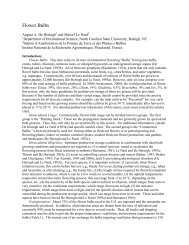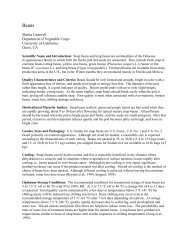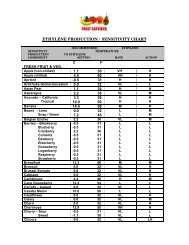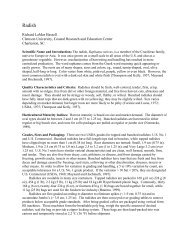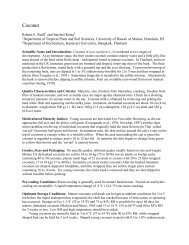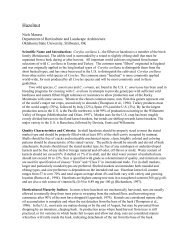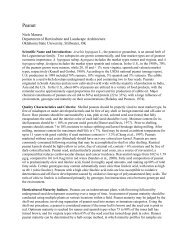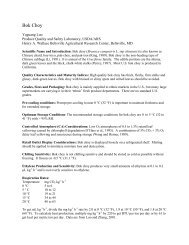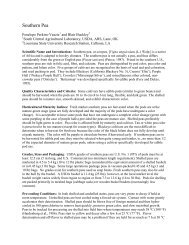Watermelon
Watermelon
Watermelon
Create successful ePaper yourself
Turn your PDF publications into a flip-book with our unique Google optimized e-Paper software.
some cases decay in MAP was higher (Biglete, 1992).<br />
Retail Outlet Display Considerations: <strong>Watermelon</strong>s are usually sold from unrefrigerated displays.<br />
Bulk fiberboard bins with colorful graphics have been a popular method of displaying watermelons for<br />
retail sale.<br />
Chilling Sensitivity: <strong>Watermelon</strong>s develop chilling injury when stored below about 10 °C for more than<br />
a few days. Lower temperatures will hasten the onset of injury. Symptoms appear as brown-staining of<br />
the rind, surface pitting, deterioration of flavor, fading of flesh color, and increased incidence of decay<br />
when returned to room temperatures (Hardenburg et al., 1986; Rushing et al., 2000; Suslow, 1999).<br />
Conditioning fruit at 30 °C for about 4 days prior to cooling has been shown to induce some tolerance to<br />
chilling temperatures, but it does not completely alleviate the problem (Picha, 1986).<br />
Ethylene Production and Sensitivity: <strong>Watermelon</strong>s are classified as low ethylene producers, with<br />
production rates in the range of 0.1 to 1.0 µL kg -1 h -1 at 20 °C. Although production rates are low, fruit<br />
are extremely sensitive to ethylene. Exposure to as little as 5 ppm ethylene causes softening, rind<br />
thinning, flesh color fading, and over-ripeness (Elkashif et al. 1989; Suslow, 1999). Interactions between<br />
ethylene concentration, temperature, and duration of exposure are not well defined. The recommended<br />
management protocol is to avoid any exposure to ethylene in the storage environment.<br />
Respiration Rates:<br />
Temperature mg CO 2 kg -1 h -1<br />
4 to 5 ºC 3 to 4<br />
10 ºC 6 to 9<br />
20 to 21 ºC 17 to 25<br />
To get mL kg -1 h -1 , divide the mg kg -1 h -1 rate by 2.0 at 0 °C (32 °F), 1.9 at 10 °C (50 °F), and 1.8 at 20 °C<br />
(68 °F). To calculate heat production, multiply mg kg -1 h -1 by 220 to get BTU per ton per day or by 61 to<br />
get kcal per metric ton per day. Data are from Hardenburg et al. (1986).<br />
Physiological Disorders: Refer to sections on “Chilling Injury” and “Ethylene Sensitivity.” A disorder<br />
of pre-harvest origin that can have serious postharvest consequences for marketing is hollowheart. The<br />
most effective way of eliminating hollowheart from the marketing chain is to utilize production practices<br />
that prevent its occurrence.<br />
Postharvest Pathology: A variety of pathogens may cause postharvest decay of watermelon, but in the<br />
absence of any approved chemical control measures, the primary defense against the occurrence of decay<br />
is the exclusion of diseased fruit from the marketing chain through careful selection at harvest and<br />
appropriate grading before shipment. Postharvest rots caused by Fusarium spp. and Phytophthora capsici<br />
are of concern because control measures for these fungi in the field often are inadequate. With good<br />
disease control in the field, anthracnose (Colletotrichum orbiculare) and black rot (Didymella bryoniae)<br />
rarely develop on watermelon (Rushing et al., 2000; Snowdon, 1992). In production areas with high RH<br />
and temperature, an extensive list of rind lesions, stem-end or blossom-end rots, and surface lesions may<br />
be caused by Erwinia or an assortment of fungi (Snowdon, 1992; Suslow, 1999). <strong>Watermelon</strong> fruit<br />
blotch (Acidovorax avenae subsp. citrulli) was a postharvest problem for several years, but research<br />
demonstrated the disease is not easily transmitted from fruit to fruit after harvest. Appropriate grading<br />
and temperature management can virtually eliminate its presence in the marketing chain (Rushing et al.,<br />
1999).<br />
Quarantine Issues: <strong>Watermelon</strong>s destined for export must be free of disease, insects, soil, or vegetative



